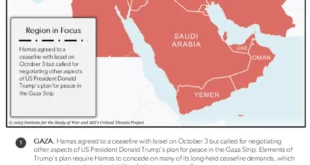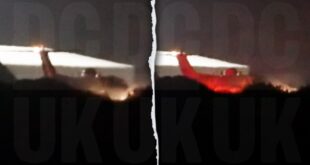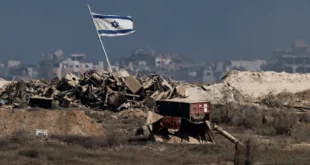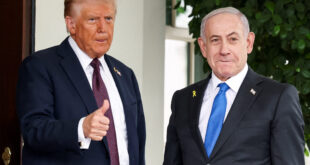Iran is limiting uranium enrichment in a signal to the U.S. and its European allies that the Islamic Republic wants to avoid escalating the dispute over its nuclear program, two Western diplomats said. The 328 centrifuges Iran uses to enrich uranium are now running only intermittently instead of at full capacity, according to the diplomats, who have direct knowledge of the International Atomic Energy Agency’s Iran dossier. The diplomats requested anonymity because they aren’t authorized to speak publicly about the investigation.
The IAEA will issue a report that the Iranians have produced a few grams of low-enriched uranium, too little to have any technical or military value, the diplomats said. In the document, to be delivered to the UN Security Council by Feb. 23, the IAEA will say that Iran continues to stonewall investigators and has taken the first steps toward installing new equipment at an underground, large-scale enrichment plant in Natanz, where the centrifuges are located.
The United Nations Security Council unanimously voted Dec. 23 to impose sanctions on Iran that limit the Persian Gulf country’s ability to acquire nuclear technology and restrict movement of Iranian scientists and technicians. The conclusions of the UN agency’s new report will likely stoke debate about whether the U.S. and its allies, which say Iran’s atomic program is a cover for weapons development, should press for tougher sanctions or seek a resumption of negotiations.
Iran will be able to install 2,000 centrifuges at Natanz within months, said the diplomats. The Islamic Republic, which says its program is intended to fuel power stations as permitted under the terms of the nuclear Non-Proliferation Treaty, said in February 2006 that it wanted to have 3,000 of the devices spinning by the end of last year. Natanz is 150 miles (240 kilometers) south of Tehran.
Nuclear Weapons
Whether Iran enriches uranium is at the heart of the conflict with the U.S. and some European countries. The centrifuges are loaded with milled uranium hexafluoride and spin up to 1,000 meters (3,280 feet) per second, separating the uranium-235 isotope, which is the material used to fuel a nuclear power plant or build a bomb.
The U.S. is “likely” to pursue more sanctions against Iran unless the country suspends its atomic work as mandated under the UN sanctions resolution, U.S. Secretary of State Condoleezza Rice said yesterday, according to a transcript of remarks to reporters on the State Department’s Web site. Tensions between Iran and the U.S. have been exacerbated by the Bush administration’s allegations of Iranian meddling in neighboring Iraq.
Sanctions Failing
Security Council sanctions have so far failed to help UN inspectors answer unresolved questions about Iran’s atomic work. The Islamic Republic still can’t account for traces of highly enriched uranium and plutonium at a waste disposal facility or adequately explain why it has blueprints that could be used to make nuclear warheads and missiles, according to the diplomats.
Iran, with the world’s second-largest oil and natural gas reserves, is likely to withstand sanctions because of its key role in international energy markets, London-based Control Risks analyst Heinrich Matthee said yesterday in an interview. Pressure to re-start U.S.-backed, European-led negotiations with Iran is likely to mount.
“It does seem to be that doing a deal today is better than making a deal a year from now,” said International Institute for Strategic Studies Program Director Mark Fitzpatrick, who worked on the Iran case for the U.S. State Department before joining the London-based organization. “It’s a strong case for doing that.”
EU Memo
The European Union forecast that “we must expect that Iran will acquire the capacity to enrich uranium on the scale required for a weapons program,” according to a Feb. 7 internal memo compiled by the staff of EU foreign policy chief Javier Solana, which was obtained by the London-based Financial Times and posted on the newspaper’s Web site.
Around 1,000 centrifuges spinning non-stop for a year can produce the necessary 25 kilograms (55 pounds) of 90 percent enriched uranium for a crude atomic bomb, according to IAEA estimates. Iran would also need to master metallurgical, chemical and explosive technologies to arm a nuclear device
Iran may be able to build a bomb by 2009 if it’s able to conceal work from IAEA inspectors, the Washington-based Institute for Science and International Security said in June.
Iran’s nuclear technicians are still encountering limited technical difficulties running the centrifuges, the diplomats said. The difficulties won’t hinder Iran from pursuing large- scale production, they added.
Switzerland, which represents U.S. interests through its embassy in Tehran, talked with Iran’s chief nuclear negotiator Ali Larijani on Feb. 12. The Swiss are pursuing ways to re-start negotiations, Larijani told the Islamic Republic News Agency after the meeting.
Criticisms of Ahmadinejad
“There are ways of enabling Iran to have a centrifuge research and development program on their soil that would be so heavily monitored so as to make it impossible to divert material,” said Rosemary Hollis, research director of Chatham House, an international relations institute in London that advises European governments. “If the Americans were to consider something like this, their policy would have more credibility.”
Some Iranians have begun to question President Mahmoud Ahmadinejad’s handling of the atomic dispute, and his stewardship of the country’s economy. Ahmadinejad-backed candidates failed to win in many contests for local posts in December and his opponents won a majority on Tehran’s City Council.
Ahmadinejad, pronounced ah-ma-deen-ah-ZHAD, faces mounting criticism from politicians and clerics concerned about his nuclear policy, denunciations of Israel, inflation and higher government spending, the Wall Street Journal reported Jan. 30.
 Eurasia Press & News
Eurasia Press & News



